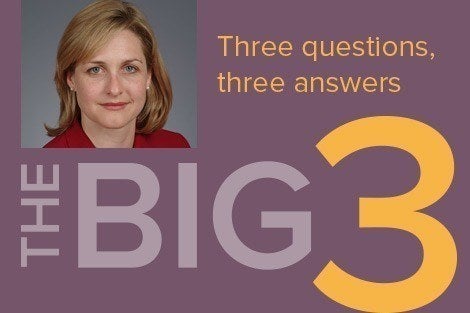November 5, 2014 — Meredith Rosenthal, professor of health economics and policy, is marking one year as Harvard School of Public Health’s associate dean for diversity. Here, she discusses goals and challenges in creating a more diverse, more inclusive School—and why it’s so important.
What’s going right at Harvard School of Public Health in terms of diversity and inclusion? And what needs improvement?
We have a diverse and dynamic community at all levels, with countless grassroots and student-led initiatives that encourage dialogue about and celebration of differences. There are also important programmatic efforts in individual departments and laboratories. For instance, we have several pipeline programs to help prepare potential future applicants from underrepresented minority groups. There are summer programs that have been in place in biostatistics and biological sciences and epidemiology for many years. We are beginning to draw from these models to strengthen our ability schoolwide to attract and retain students from underrepresented groups.
How is the School doing with regard to increasing the number of women and minority faculty?
Over the last decade, we’ve increased our numbers of junior women faculty significantly; about 40% of our assistant and associate professors are women. The numbers in the senior faculty are, not surprisingly, lower—about 23% of full professors are women. The senior faculty numbers haven’t increased as much in part because of the low turnover of full professors and the long tenure track. Still, we can do more to retain women faculty and ensure they get the support they need to be successful through a variety of initiatives, such as providing them with seed funding for innovative research or offering more junior faculty sabbaticals. These kinds of supports make their lives here better and make them less likely to look favorably on outside offers.
As for underrepresented minority faculty, our numbers are not where we’d like them to be. We have made significant gains in recruitment and retention over the last several years, but we have much work to do in this area.
What are some other ideas and initiatives being pursued to make the School a more diverse, inclusive place?
When it comes to inclusion, what we’re really thinking about is life at the school—allowing people to be their authentic selves and thrive here as students and as professionals. Things that can help in this regard include cultural awareness activities and training. With our Dean’s Advisory Committee on Diversity and Inclusion (a committee of students, staff, and academic appointees that advises me and the Office of Diversity and Inclusion on policy and programs) we are developing some workshops right now that we hope to bring to the entire community in the near future. We also are paying attention to how we communicate both internally and externally as a school. The goal is to make sure that we raise the profile of our community members from underrepresented backgrounds, use inclusive language, and highlight diversity and inclusion as a core part of our work in public health.
Another area I’m excited about is community engagement. There are already departments and student groups that have their own community outreach efforts—they have partners in Mission Hill that they work with regularly. We’d like to expand these sorts of initiatives because they offer valuable opportunities for students, staff, and faculty to work together in support of our community.
The Dean’s Advisory Committee on Diversity and Inclusion and the Committee on the Advancement of Women Faculty have played, and will continue to play, an important role in representing community concerns and helping identify priorities. The bottom line is that we want to engage everyone in issues of diversity and inclusion—not just those who are already interested. We want to work with students, faculty, and staff to involve them in conversation about our challenges, and to plan, together, where we’d like to go as a community. Our message—and I think it’s a genuine one—is that, to be a successful public health professional, you need to be culturally competent.
